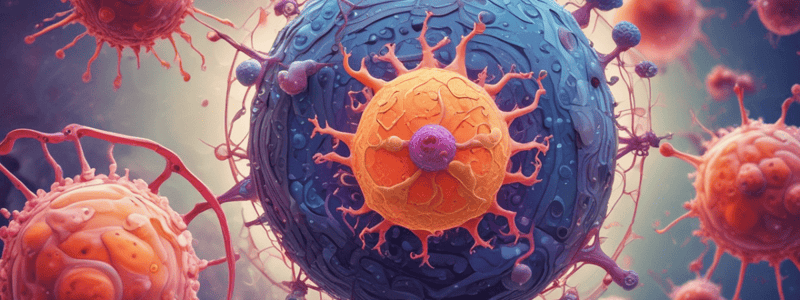Podcast
Questions and Answers
What type of macrophages are found in the liver?
What type of macrophages are found in the liver?
- Kupffer cells (correct)
- Microglial cells
- Osteocytes
- Alveolar macrophages
Which type of lymphocyte is primarily responsible for secreting antibodies?
Which type of lymphocyte is primarily responsible for secreting antibodies?
- B lymphocytes (correct)
- CD4+ T lymphocytes
- TH2 cells
- TH1 cells
What is the main function of eosinophils in immune reactions?
What is the main function of eosinophils in immune reactions?
- Mediating allergic inflammation (correct)
- Cytotoxicity against mammalian cells
- Phagocytosis of bacteria
- Secreting cytokines
Which CD4+ T lymphocyte subset is associated with allergic reactions?
Which CD4+ T lymphocyte subset is associated with allergic reactions?
How do macrophages and lymphocytes interact in chronic inflammation?
How do macrophages and lymphocytes interact in chronic inflammation?
What triggers the recruitment of eosinophils during immune reactions?
What triggers the recruitment of eosinophils during immune reactions?
Which type of macrophage is located in the lungs?
Which type of macrophage is located in the lungs?
What is the role of CD4+ T lymphocytes in inflammation?
What is the role of CD4+ T lymphocytes in inflammation?
What is a potential negative effect of eosinophils during allergic reactions?
What is a potential negative effect of eosinophils during allergic reactions?
Which of the following macrophages is primarily responsible for immune surveillance in the central nervous system?
Which of the following macrophages is primarily responsible for immune surveillance in the central nervous system?
Flashcards are hidden until you start studying
Study Notes
Macrophages in Specific Locations
- Kupffer Cells located in the liver play a crucial role in filtering blood and immune response.
- Microglial Cells are the resident macrophages in the Central Nervous System, involved in brain health and repair.
- Alveolar Macrophages reside in the lungs and are essential for clearing pathogens and debris from alveoli.
- Sinus Histiocytes are present in spleen and lymph nodes, functioning in the immune system's response to infections.
- Osteocytes in bone serve as stress sensors and contribute to bone remodeling and immune responses.
Role of Lymphocytes
- Lymphocytes are pivotal in driving inflammation in autoimmune and chronic inflammatory diseases.
- Activation leads to B lymphocytes transforming into plasma cells that secrete antibodies.
- T lymphocytes, upon activation, secrete cytokines that regulate immune responses.
- CD4+ T Lymphocytes are instrumental in promoting inflammation and determining the inflammatory reaction type.
- Subsets of CD4+ T lymphocytes (TH1, TH2, TH17) have specific cytokine profiles and elicit distinct inflammations:
- TH1 and TH17 Cells defend against bacteria and viruses as well as contribute to autoimmune diseases.
- TH2 Cells are active against helminthic parasites and in allergic responses.
Lymphocytes and Macrophages in Chronic Inflammation
- Lymphocytes and macrophages interact in a bi-directional manner, showcasing their unique reciprocal relationship in chronic inflammation.
- The collaborative dynamics enhance the immune response and inflammation regulation.
Eosinophils
- Eosinophils are primarily involved in IgE-mediated immune reactions and parasitic infections.
- Recruitment is influenced by eotaxin, a chemokine that primes eosinophils for movement towards the site of infection.
- Contain Major Basic Protein (MBP), a toxic cationic protein to parasites but harmful to mammalian epithelial cells, leading to tissue damage in allergies.
Mast Cells (Basophils)
- Found extensively in connective tissues, mast cells participate in both acute and chronic inflammatory processes.
- They express receptors binding to the Fc portion of IgE, crucial for allergic reactions.
- Degranulation of mast cells results in the release of histamines, mediating inflammatory responses.
Studying That Suits You
Use AI to generate personalized quizzes and flashcards to suit your learning preferences.




